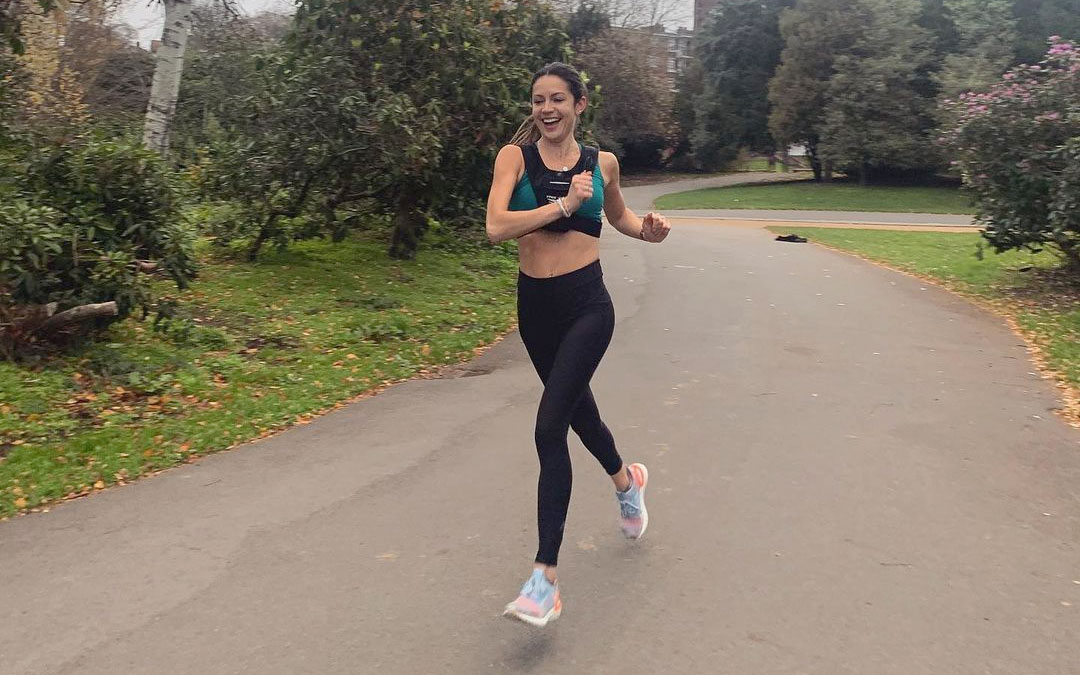I ran 5K every day for a month and this is what happened
From weight loss to mental clarity, our writer reaped the rewards of running 5K every day, but would she still do the challenge today?


Lucy Gornall ran 5K every day for 30 days in 2020. We went back to her almost four years on for her perspective on the challenge now. We begin with the original article, edited for clarity, followed by Lucy's views on whether she'd run 5K every day now.
I have never classed myself as a runner—as a personal trainer, I prefer gym-based sessions. However, when I ran 5K every day for a month, I quickly realized why people choose running as their go-to exercise.
Aside from cross country and athletics at school, I only really ever used to run at the gym—opting for sprints, hill climbs and the odd quick 2km treadmill run. I also teach at a studio in central London which incorporates short runs. But, when the COVID lockdown kicked in and gyms closed here in the UK, running soon became my escape.
I ran until my knees creaked and my feet were sore. I didn’t stop. Then when the gyms reopened, alongside my usual regime of resistance training, CrossFit-esque workouts and boxing, I vowed to keep up the runs. So that's where my run-5K-every-day-for-30-days idea came from. Revolutionary, right?
Regardless, every day I taped up my knees, pulled on my running shoes and set my Apple Watch to 5km timer mode. Here's an account of what happened to me by day 30 of 5K every day.
I lost weight
Yup, I did. A couple of kilos actually, without changing any part of my diet. In fact, if anything, it felt like I was eating more. But the scales said otherwise.
Running may be one of the best exercises for weight loss, but that certainly wasn't my goal when I set out running 5K a day. However, as I was burning an extra 300-400 calories a day from this run according to my Apple Watch and still following my usual routine on top of this, some weight loss was inevitable.
I noticed my joints aching
Gah, the pitfalls of aging. However, at just 29, I figured my joints were fairly resilient. Yet, when I bend my right knee, it now emits a weird cracking sound. It doesn’t actually hurt, but the noise it makes sounds like total agony.
Start your week with achievable workout ideas, health tips and wellbeing advice in your inbox.
The impact of running on joints is one reason why every runner should get a gait analysis and ensure they're wearing shoes with suitable support. More on that later...
I got quicker and fitter
You know the saying, "it doesn’t get easier, you just get better"? Well, that definitely rang true. Outdoors I was running 5K in just over 21 minutes, whilst my best treadmill time was 18 minutes—both PBs by some margin. So I was a pretty smug Sally after that.
A post shared by - Lucy E Gornall - (@lucyelizabethgornall)
A photo posted by on
My cravings decreased
I thought that running more—and therefore burning more calories—would increase my cravings for sugary, carby foods. Actually, it did the opposite. I didn't hanker after chocolate at 3pm and I wasn't raiding my snack cupboard after dinner for a suitable dessert. Nope, I was quite content just eating my meals and then having no more.
I realised the importance of good running kit
As a PT, I’ve seen my fair share of dodgy workout footwear (Converse on a treadmill was an interesting one), but take my word for it—shoes are important.
Honestly, don’t even attempt to run in cross-training shoes, or any shoe that has a flat, hard sole, for that matter. Think about it; you’re pounding a solid floor continuously, and your joints are basically being smashed around. So, do yourself a favor and invest in good running shoes.
I became a Podcast nerd
You soon realise that pounding dance music playing in your ears can start to become a little, well... repetitive. So I popped in my earbuds and tuned to podcasts.
My particular running favorites included The James Smith Podcast by the PT-turned-bestselling author of Not A Life Coach, Couples Quarantine with super-fit husband and wife duo James Haskell and Chloe Madeley, and The Model Health Show, which sees health guru Shawn Stevenson interview world-renowned experts on fitness, nutrition, personal development and more.
I became more in tune than ever with my bowels
TMI alert! Things are about to get intimate, because I feel it's necessary to tell you of my incredibly close-call incidents in relation to my bowel movements when out running.
A few times, nowhere near my home or a public convenience, I found myself looking around desperately wondering where I could, err, relieve myself. Honestly, that's how bad it gets. You actually picture yourself squatting down behind a bush to do a number two. It's horrific and it hurts.
FYI, I never got quite so desperate as to relieve myself in public—phew. But maybe that played a role in me getting faster!?
My mind was clearer
Some days I would head out on a run with a million thoughts running through my head. Whether it be a to-do list that was stressing me out, a recent negative news story (a fairly common scenario in the current climate), or a boy-related drama, going for a run just sorted it all out. Which leads me onto…
Decisions were made
Along with shower time and bedtime, running has now become a time when I make key decisions. Should I message him back? What kind of reply does that work email warrant? Do I opt for black or duck-egg blue curtains? What color should I paint my nails? All really important decisions, as you can tell—and all decided on my daily runs.
Four Years Later
And now?
So what’s been going down since my 5k-every-day challenge four years ago? Well, I’ve upped the distance just a touch. I’ve run marathons—achieving my PB of 3hr 15min in London last year—and a trail ultra marathon. I now regularly run at least three to four times a week covering various distances.
But running every day? That’s definitely, 100% stopped, because ultimately, running every day allows little time for recovery, and a lack of recovery can lead to injuries, exhaustion, mood swings, fatigue—the list goes on.
Jake Dearden, personal trainer and HYROX master trainer says that running every day "can put a lot of strain on your body and lead to issues with your muscles and joints. This is especially true if you're not giving your body enough time to recover. Over time, this could lead to serious injuries, such as shin splints, tendonitis or even stress fractures."
In fact, when I asked Dearden if he'd recommend that anyone run 5K a day, he said he wouldn’t even suggest it to the very experienced runners. "Running without variation in intensity or distance is simply not optimal for improving performance and it's not a very enjoyable way to train. It can get boring and result in loss of motivation."
So with that in mind, here's what I've learned since taking on my challenge.
Slow runs are the best runs
Rather than pounding the pavement at maximum speed on every run, I now vary my runs, incorporating more slow runs. These not only help me to build up my endurance without hammering my body, but research has found that running slow can help you to run fast.
Studies have found that those who spend more time slow running actually have a greater VO2 max (essentially the amount of oxygen your body can take in and use during exercise) and run around 1% quicker. Plus, slow running builds an aerobic base, which improves your ability to perform steady exercise for a long period of time.
Food is essential for recovery
If you're feeding your body with non-nutritious foods, you can't expect it to work optimally.
"Post-run recovery is all about refueling with the right balance of carbohydrates, protein and healthy fats to help your muscles recover," says Dearden. "My go-to carbs are porridge, pasta and bagels."
He adds that these carbs are great for replenishing glycogen stores. Glycogen is a form of glucose which provides energy for your body and is depleted during a run.
"For protein, lean meats like chicken and fish, and eggs are going to be important for muscle repair and building," says Dearden. "Healthy fats from avocados, eggs, nuts and fatty fish like salmon are also important for joint health and reducing inflammation."
Don't forget electrolytes either. Personally, I have started taking these after exercise every day—in the form of effervescent tablets—and my body definitely feels more alive post-workout.
Protect your joints with strength training
When I did my 5K-every-day challenge, I noticed my joints starting to ache and, worryingly, creak. Although my knees are still creaking, since cutting down the runs and focusing more heavily on strength training, I've noticed a huge reduction in how much my knees ache.
"Incorporate strength and mobility work," says Dearden, "especially exercises targeting muscle imbalances, such as step-ups, single-leg Romanian deadlifts and split squats. This helps stabilize joints and maintain proper form, which reduces the risk of injury."
Stretching is boring but essential
We've all turned a blind eye to our warm-ups and cool-downs but they're crucial if you want to keep moving comfortably.
Dearden agrees that stretching and mobility are really important, and the more consistently you do them, the more effective they become.
"If you can fit it in, some form of mobility work daily is ideal. This can include things like foam rolling and dynamic stretches, like leg swings and kickouts, before your runs. Post-training, focus on static stretching or even yoga to help with flexibility and recovery."
Lucy is a freelance journalist specializing in health, fitness and lifestyle. She was previously the Health and Fitness Editor across various women's magazines, including Woman&Home, Woman and Woman’s Own as well as Editor of Feel Good You. She has also previously written for titles including Now, Look, Cosmopolitan, GQ, Red and The Sun.
She lives and breathes all things fitness; working out every morning with a mix of running, weights, boxing and long walks. Lucy is a Level 3 personal trainer and teaches classes at various London studios. Plus, she's pre- and post-natal trained and helps new mums get back into fitness after the birth of their baby. Lucy claims that good sleep, plenty of food and a healthy gut (seriously, it's an obsession) are the key to maintaining energy and exercising efficiently. Saying this, she's partial to many classes of champagne and tequila on the rocks whilst out with her friends.
